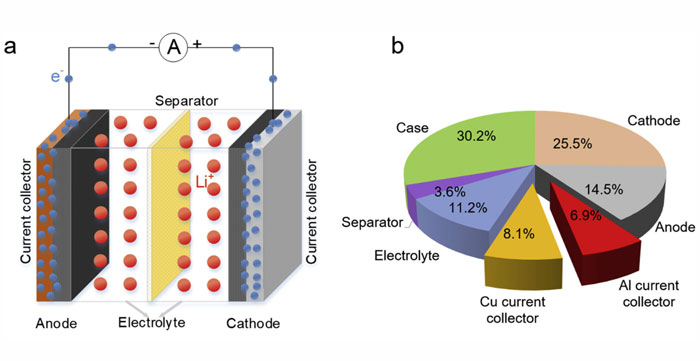What Are The Raw Materials Of Lithium Batteries?
Lithium batteries are an important part of electric vehicles, mobile phones and other products. Understanding the resulting raw materials of lithium batteries will help us better recycle and reuse discarded lithium batteries.
Lithium-ion battery raw materials are mainly composed of: positive electrode material, negative electrode material, separator, electrolyte.

Lithium battery composition material
Cathode material:
It has the largest market capacity and high added value in lithium-ion batteries, accounting for about 30% of the cost of lithium batteries, while the gross profit margin is 15% when it is low, and more than 70% when it is high. The performance of the cathode material directly affects the performance of the lithium-ion battery. The most commonly used materials are lithium cobalt oxide, lithium manganate, lithium iron phosphate and ternary materials (polymers of nickel, cobalt, and manganese).
Negative electrode materials:
There are mainly carbon negative electrode materials and non-carbon negative electrode materials. Among them, carbon anode materials are widely used in commercial lithium-ion batteries due to their advantages such as safety, long cycle life, low price, and non-toxicity. The disadvantage is that the mass specific energy is relatively low. Non-carbon anode materials are divided into lithium transition metal nitrides, transition metal oxides and nano-alloy materials according to their composition. It has high volumetric energy density, but poor cycle stability, large irreversible capacity, and high preparation cost, so it has not been industrialized. Currently, he is exploring the combination of carbon materials with various high-capacity non-carbon anode materials to develop high-capacity, non-carbon composite anode materials.
Diaphragm:
Diaphragm is a thin film used to separate the positive and negative electrodes during the electrolysis reaction of lithium ion batteries to prevent energy loss from direct reaction in the electrolytic cell. Its performance determines the interface structure and internal resistance of the battery, which directly affects the capacity, cycle and safety performance of the battery. The market-oriented separator materials are mainly polyethylene (PE) and polypropylene (PP). The polyolefin (Polyolefin) type diaphragm, of which PE products are mainly obtained by wet process, and PP products are mainly obtained by dry process.
Electrolyte:
The electrolyte plays the role of conducting ions between the positive and negative electrodes of the lithium battery, which is the guarantee for the lithium ion battery to obtain the advantages of high voltage and high specific energy.
The above is a detailed introduction to the composition materials of lithium batteries. Due to the complex characteristics of lithium batteries, lithium battery recycling requires a complete set of solution processes. SUNY GROUP, as a professional lithium battery recycling solution and manufacturer, has rich experience and First-class technical equipment, if you need it, you are welcome to contact us.



